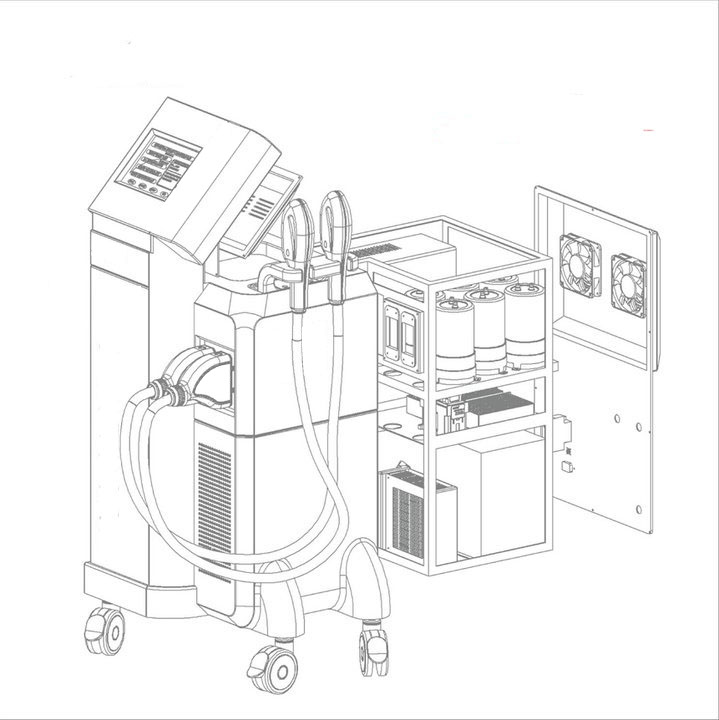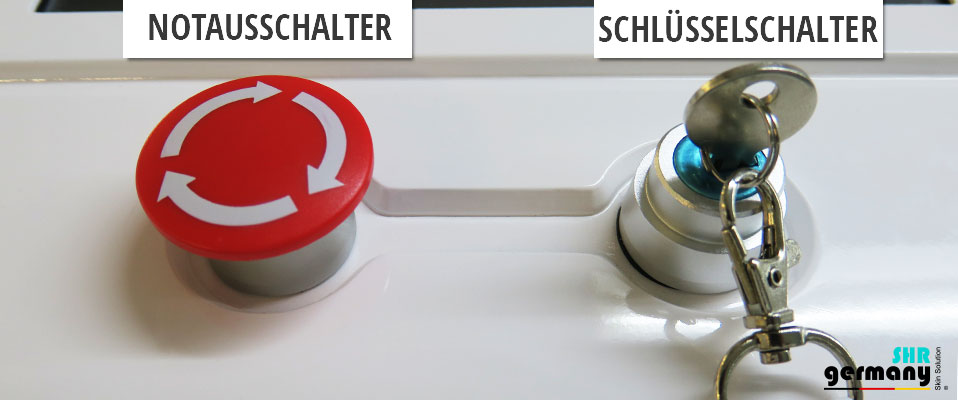IPL - What is it exactly?

The Xenon-pulse light, also known as IPL (Intense Pulsed Light), is high-energy flash lamps which are built around the handpiece. The flash lamp emits the broad-spectrum "white light" of all wavelengths. The wavelengths of the "white light" are cut by means of filters (filter glass, water flow paths). For each application, you need different wavelengths, therefore filters. The wavelength starting frequency is decisive, for example, for permanent hair removal, the frequency range 580-640-755 (starting frequency depending on skin type from brighter to darker) - 1200 nm (nanometer) is the ideal range. For this reason, the handpieces of our devices are generally limited to 1200 nm wavelength by a water filter. The xenon pulse light lamp is stored in water (H²O) and shoots out of the water. Water is a natural filter for all infrared wavelengths from 1200 nanometers.
This means for our equipment users the best treatment results and no pain for the customers.!
The prevailing start of absorption depends on the wavelength starting frequency. For example, 420 nm is absorbed to a maximum in HbO2 (oxyhemoglobin).
Of course, there are other filters for other skin types, above mostly only for the European skin type.
IPL technology in detail
You can read everywhere about the IPL technology and mostly you find the same information. But what about the technology in the device? How does the device work technically? What is useful and what is not?
The answers you find in the following:
What is generally in an IPL device?
Power adaptor
Capacitors
Transformers
CPU / microcontroller / memory
Display/output unit
Interfaces (USB / Serial)
Plugs and contacts
Water pump and tank
Hoses
Ventilators and radiators
Sensing element and sensors
Peltier element
The best way to start is the practical part of a training course, where you can look at the device from all sides.
Firstly, you have to look at the display, the red button with arrows on it and the key, which is in the lock, where again the yellow ring drum. This is virtually the center, the visual control for the users.
The key is always switched off (at the position 0); for switching on the device you have to turn it to 1.

The red button is an emergency stop switch, which immediately turns off the machine when you operate it.
After the operation, the button must be turned back again, so that the machine can be started again.
If you have noticed that the emergency stop is on and you turn the key to "1", the device starts and the display goes on.
Depending on the device, different start screens can be displayed.
Some devices show the initialization, what is firstly checked before it changes into the operating mode.
In the initialization, all safety-related aspects of the device are checked, such as cooling water flow, water volume, water temperature, handpiece cooling (Peltier elements), ventilation, tension, software inquiry etc. If everything is in order, the display changes into the operating mode. Further information you can find in another chapter.
The handpiece

The electronic cooling in the handpiece, also known as semiconductor cooling, which in turn would mean electronic semiconductor cooling, is, in reality, a peltier element, an electronic component that can generate either heat or cold by adding power. It was named after its inventor, Jean Peltier.
As can be seen from the image on the sapphire coupling, the Peltier element is extremely efficient and cools the coupling to below 0 ° C!
Duo-Peltier Elements
Our new-developed Duo Peltier elements are even more efficient by restructuring and innovative displacement of the two electrical elements inside the component. As a result, we have achieved a 25% cooling increase with a lower energy supply.
The energy
The right light intensity or energy (unit of measure Joule in Watts / s) as further components of permanent hair removal. To be effective, the filtered light must be strong enough to destroy the hair roots. This strength or energy is measured in joules per cm² for a particular pulse duration. Comparing different producers, this energy power should always be measured on the handpiece of the IPL device and in cm² with the respective pulse duration indicated. Remark: the indication of the Joule number without area indication in cm² and without pulse duration has no meaningful information about the performance of the device. Correct information: e.g. 10 joules per cm² for 10 ms. This value can be used to determine the effective power capacity of the IPL device. For some devices, the description for implementation of the power measurement is provided. It is easy to notice, however, that all parameters should be fully imprinted and pressed into the power measuring device, designed for this purpose. There are sometimes confusing values which the manufacturer create, such as, "The measurement device should show between 60 and 90 joules after a successful measurement"? Then there is a question how the device, which effectively max. 50 Joule can provide, can achieve at once 60 to 90 joules? Quite simply, we always forget that the specified performance data occurs in Joule per cm² with a certain pulse length! In a handpiece, for example, that sapphire coupling of 15 x 20 mm has, it would be 3 cm², that is the whole value of the measurement by 3, and see, it comes from 20 to 30 joules per cm². In addition to a high-performance power adaptor with sufficient power (watts), the generated energy of the light pulse also depends on further components, such as capacitors.
What is a capacitor?
It has nothing to do with our clothes dryer in the basement, it is energy storage. This energy storage can be imagined as a battery, but capacitor can deliver lightning-fast the stored power and thus supplies the xenon lamp with power several times for a fraction of a second. If these capacitors are of poor quality or undersized, the lamp does not get enough energy or the pulses are not "clean" enough, you can forget the settings, which were made before with the subimpuls, all of them are in the millisecond range.
Many details play an important role in the processing of an IPL device. For example the cabling of the capacitors. If this is too poorly arranged, it causes high energy losses due to high resistances on the wires. You can see this as follows: If you have a water hose, which is 50 meters long, which you use to irrigate the garden, and the diameter of the water hose is 2 centimeters, then, at normal water pressure public utility, a lot of water flows out. Now we take the hose with only a half-centimeter diameter, the water quantity decreases.
Comparing to the capacitors and the wire, the wire is made not of rubber like in water, but of copper, and instead of public utility that produces the water pressure, the capacitors produce the pressure. The copper cable of a good cabling consists mostly of solid copper bars in the area around 25 mm², which are screwed tightly to the capacitors. These bars have an internal resistance to 0 Ohm, a few milliohm are of course available, but it is optimal conditions for good power transmission.
Poor cabling looks like the wire is made either of a much thinner copper cable, down to 2.5 cm² or was installed with the cheap cable connector. Thus the internal resistance of the wire is still 0 Ohm, but this thinner cable warms stronger and more quickly when power is added since the friction losses of the electrons in the copper are much stronger, this thin cable has much poorer features. Even worse, the capacitors are then also wired with cheap silver-alloyed steel wire. There are the line losses 10 times higher than with copper!
We always pay attention that our devices have the proper cabling and sufficient dimensioning!
Energy alone is not enough to achieve reliable results in permanent hair removal.
The performance of IPL device also depends decisively on other criteria:
- The duration of a flash (pulse duration)
- The subimpulses (pulse interruptions)
- The waiting time between 2 flashes
- The size of the contact piece surface
- The Xenon lamp
- The cooling system
Die Dauer eines Flashs (Pulsdauer)
Je nach Hauttyp, Haartyp und Haardichte muss die Pulsdauer unterschiedlich sein. Aus diesem Grund sollte ein IPL-Gerät über eine einstellbare Pulsdauer verfügen. Wenn das Haar viel Melanin enthält, kann das Licht so schnell absorbiert werden, dass das Haar verbrannt wird, bevor es die Wurzel erreicht hat. Aus diesem Grund muss es möglich sein, die Pulsdauer im Bereich von 5 ms bis maximal 50 ms einstellen zu können.
The duration of a flash (pulse duration)
Depending on the type of skin, hair and hair density, the pulse duration must be different. For this reason, IPL device should have an adjustable pulse duration. If the hair contains a lot of melanin, the light can be absorbed so quickly that the hair is burned before it reaches the root. For this reason, it must be possible to set the pulse duration in the range from 5 ms to a maximum of 50 ms
The subimpulses (pulse interruptions)
The subpulses are spread over the length of an impulse. For most of our devices is possible to set up to 15 sub-pulses in a single pulse! The delay time, that is, the waiting time between the individual subpulses can also be adjusted additionally. To illustrate this, take a look at the graphic: You can see here an impulse, called a pulse interval, whereas this impulse can be subdivided into these small rectangular pulses. It has the purpose to create even more treatment parameters, in order to achieve the most optimal result even in the most difficult applications. Sure, these setting we start operating at our first training, but you can improve your knowledge only by using it. Then you can understand these parameters and will be able to apply them at all. For this reason, we offer a further training course after half a year, which deals specifically with the complex setting possibilities.
The waiting time between 2 flashes is more important than you think!
The effect of the waiting time between 2 flashes is largely underestimated. Depending on the IPL device, the waiting time can vary between 1 to 8 seconds. This is an enormously important performance criterion. In connection with the treatment area of the handpiece, the treatment time results per customer. The waiting period highly influences the treatment prices.








